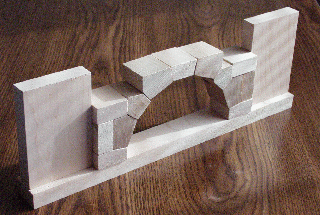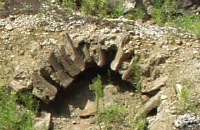
This wooden arch comes from Edmund Scientific.
Michael Behe claims that many biological systems could not have evolved because they are irreducibly complex:
By irreducibly complex I mean a single system composed of several well-matched, interacting parts that contribute to the basic function, wherein the removal of any one of the parts causes the system to effectively cease functioning. Darwin's Black Box, p.39

This wooden arch comes from Edmund Scientific. |

This stone arch is in the Roman ruins in front of Franz Joseph Palace in Austria, Vienna. (click link for full view.) |
Yet it is clear that such arches could form in nature without an intelligent agent. For example, a landslide could put a pile of rocks onto a stream bed. The stream may then erode the pile to leave an arch.

There are spectacular large arches carved out of stone in the South west of the United States at Arches National Park. (google: Arches National Park) |
Likewise, "Biochemical scaffolding" could have once existed that is now gone. One might imagine that the scaffolding does not have an advantage and therefore the scaffolding must be externally directed, but that would miss the point. In a biological system many variations can appear that have no significance, such as a duplicate gene, but sometimes the variations become advantageous. Eventually they may become required and at this point they would no longer be "scaffolding".
The Ev paper shows that the genomes of the evolved creatures have exactly the properties required by Behe to be "irreducibly complex" and yet they evolve from scratch. This demolishes Behe's "irreducible complexity" argument.
The kind of arch does not matter! Some people think that just because Roman Archs are made by a people, that this disrupts the argument. However, a simple counter example is to notice that there are arches in nature too, such as found at the Arches National Park in Moab, Utah.
Scaffolds do not imply goals! Is the sea a goal of a river? No. To form an arch is a straightforward physical process in which layers of material are formed, raised up, and then undercut from the side to remove the "scaffold". Alternatively, a U shaped rock could be turned up by, for example a landslide. There is no outside goal being met, and if the system fails to make an arch there is no consequence.
I sent an email to Behe to ask him about this issue:
From toms Thu Aug 5 01:38:27 1999 To: mjb1@lehigh.edu Subject: question about irreducible complexity Content-Length: 1757 To: Michael Behe Dear Mike: I just read your interesting and well written book "Darwin's Black Box". Thank you for sending me a copy. I have a question about your thesis and I would like to post our correspondence on my web site. May I have permission to do so? The question is whether you would consider a genetic control system to be irreducibly complex. Your definition is: By irreducibly complex I mean a single system composed of several well-matched, interacting parts that contribute to the basic function, wherein the removal of any one of the parts causes the system to effectively cease functioning. (p.39) In each genetic control system there is a recognizer (protein or RNA/protein such as the ribosome or spliceosome) that recognizes and binds to specific places on DNA or RNA, and in doing so controls some function such as the expression of a set of genes. The recognizer is well-matched to the binding sites, and they interact to perform the basic function. Both contribute to the control. If the recognizer didn't exist or was not functional, the control would not work. If the binding sites had the wrong sequence or were in the wrong places, they would not work. As I understand your concept, this meets your criteria for an irreducibly complex system, since lack of any component leads to failure of the system. Since each depends on the existence of the other for function, isn't the entire system of recognizer and binding sites "irreducibly complex"? Thank you, Tom Dr. Thomas D. Schneider toms@alum.mit.edu permanent email: toms@alum.mit.edu http://www.lecb.ncifcrf.gov//
Michael Behe refused to allow me to post his response. In December of 1999 I sent him a Roman Arch.
2006 May 18: I have written a Summary of Behe's response.
Thornhill RH, Ussery DW. A classification of possible routes of Darwinian evolution. J Theor Biol. 2000 Mar 21;203(2):111-6. PubMedThey say that Dawkins `argues that no biological, and very few structures are "brittle", and gives the arch as his sole example of one (Dawkins, 1995, pp. 82-83).' DAWKINS, R. (1996). River Out of Eden: A Darwinian view of life. New York: Phoenix. So River Out of Eden may be the first use of the arch as an example. (NB: error in reference because the authors didn't use LaTeX/BibTeX!)
Your Roman arch argument is glaringly fallacious and misleading. The Roman arch by design and construction requires a transcendent intelligence. If you wish to compare apples to swordfish than apply the same constants to both. A scholar of your caliber can certainly do better than this, ..... disappointed.Thanks for your comment. The argument given on this page was missing some steps! I added the notes about natural arches.
Thomas,
I happened to come across your challenge to Behe's irreducible complexity hypothesis. I read his work years ago and more recently came across some interviews with him. John Burnett was right to challenge your Roman arches approach and I don't believe your amendment offers a more lucid explanation.
Geological landforms are not biological structures, and do not experience mutations, as such. The dead material of stone simply lies there while it is formed by erosion. It does not select or discard variations in its form, it does not retain beneficial endowments - it simply takes what it gets and carries on with no descent toward complexity, only the mindless effects of the elements, until such time as the structure collapses from the detrimental carelessness of random process. In fact, given time, it is a certainty that the "random mutations" of erosion will destroy the structure. Who knows but there are hundreds of such collapsed arches in the world, desguised as heaps of broken stone.
To put this into perspective, remember that you're comparing an enormously complex biological system to a single massive formation of inanimate sandstone. I fail to see any challenge here to Behe's work.
Respectfully,
m.
Note also, as many people have pointed out, that Behe's argument goes like this: "I can't think of a good evolutionary argument for how this might have come about and I'm too busy to spend the next 40 years of my life doing the hard work to figure it out. So I'll just take the easy way out and suppose it was supernatural."
In his response to me (Tue Aug 10 13:22 EDT 1999) Behe did not consider protein binding to DNA to be irredicubly complex and he gave several reasons. I will paraphrase his response here. First, he did not think that binding is a function. Secondly, binding can happen by small steps and so is 'reducible'. Third, one would have to consider more than the binding and that is messy. He said he had not followed this line of thinking enough to draw a solid conclusion and suggested that it would be good for me to look into these probems.
Here are my responses on 2006 May 18:
1. Most molecular biologists would say that binding is a biological function. Without correct binding an organism will die, so it is one of the most important functions in biology and it occurs in all living molecular systems. To use Behe's example, which he mentioned, the flagellum is constructed by binding parts together and I suggest (based on advanced molecular information theory) that its mechanism will eventually be shown to involve binding reactions.
2. That something could evolve in small steps was not part of Behe's original definition. So here he has changed his definition. If we cannot agree on a single definition, then the concept of 'irreducible complexity' evaporates. However, during the Dover Trial in 2005, Behe used a new definition almost identical to the one above, with a minor language difference that seem meaningless to me, so I will stick to the original definition until Behe publishes a complete revision.
3. It is indeed true that binding is part of a larger system. However, this complexity is not part of the definition of irreducibly complex and therefore must be excluded from the argument. Furthermore, the Ev program (which I published the year after these emails) shows clearly that the complexity can be modeled in precise parallel to the natural genetic control systems and that the Ev model gives results identical to the naturally observed ones, namely that Rsequence evolves towards and oscillates irregularly around Rfrequency.
So to summarize, none of Behe's private arguments to me withstand close scrutiny.
This is interesting because Darwin's Black Box was first published in hardcover in 1996, more than 10 years after Cairns-Smith demolished the irreducibly complex idea!Third clue from the building trade To make an arch of stones needs scaffolding of some sort; something to support the stones before they are all in place and can support each other. It is often the case that a construction procedure includes things that are absent in the final outcome. Similarly in evolution, things can be subtracted. This can lead to the kind of mutual dependence of components that is such a striking feature of the central biochemical control machinery.
This third clue alerted us to the likelihood of a missing agent, an earlier `scaffolding' --- an earlier design of organism at the start of evolution. And it seemed very possible that these first organisms would have been based on a genetic material no longer present at all in our biochemistry.
![]()

Schneider Lab
origin: 1999 Aug 05
updated: 2013 May 01
![]()